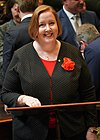Government of New South Wales
| Government of New South Wales | |
|---|---|
 The logo that represents the executive government specifically. The coat of arms of New South Wales represents the state as a whole. | |
| Overview | |
| Established |
|
| State | |
| Country | |
| Leader | Premier of New South Wales (Chris Minns) |
| Appointed by | Governor of New South Wales (Margaret Beazley) on behalf of the King (Charles III) |
| Main organ |
|
| Ministries | 11 Government Departments |
| Responsible to | Parliament of New South Wales |
| Annual budget | $120.2 billion[1] |
| Headquarters | Sydney |
| Website | nsw |
The Government of New South Wales, also known as the NSW Government, is the governing body of New South Wales, Australia. The executive government comprises 11 portfolios, led by a ministerial department and supported by several agencies. There are also a number of independent agencies that fall under a portfolio but remain at arms-length for political reasons, such as the Independent Commission Against Corruption and Electoral Commission. The state Executive Council, consisting of the governor and senior ministers, exercises the executive authority through the relevant portfolio.
The legislative branch includes the bicameral state parliament, which includes the monarchy as represented by the governor, the Legislative Assembly, and Legislative Council. The judicial branch consists of three general courts (Local, District and Supreme Court), and several specialist courts such as the Children's Court or Coroner's Court.[2]
New South Wales received statehood upon the federation of Australia in 1901, with the state's Constitution establishing a parliamentary democracy. Its relationship with the federal government is regulated by the Australian Constitution. The current government is held by the state Labor Party, led by Premier Chris Minns. Minns succeeded Dominic Perrottet from the Liberal Party on 28 March 2023 following the state election.
Political structure
[edit]New South Wales is governed according to the principles of the Westminster system, a form of parliamentary government based on the model of the United Kingdom. Legislative power formally rests with the King, acting with the advice and consent of the Legislative Council and Legislative Assembly—together known as the Parliament of New South Wales.[3] Executive power is exercised by the Executive Council, which consists of the Governor and senior ministers.[4]
The Governor, as representative of the Crown, is the formal repository of power, which is exercised by him or her on the advice of the Premier of New South Wales and the cabinet. The Premier and ministers are appointed by the Governor, and hold office by virtue of their ability to command the support of a majority of members of the Legislative Assembly. Judicial power is exercised by the Supreme Court of New South Wales and a system of subordinate courts, but the High Court of Australia and other federal courts have overriding jurisdiction on matters which fall under the ambit of the Australian Constitution.
In 2006, the Sesquicentenary of Responsible Government in New South Wales, the Constitution Amendment Pledge of Loyalty Act 2006 No. 6 was enacted to amend the Constitution Act 1902 to require Members of the New South Wales Parliament and its Ministers to take a pledge of loyalty to Australia and to the people of New South Wales instead of swearing allegiance to the Queen her heirs and successors, and to revise the oaths taken by Executive Councillors.[5] The Act was assented to by the Queen on 3 April 2006.
On 5 June 2012 the Constitution Amendment (Restoration of Oaths of Allegiance) Act 2012 No 33 was assented to and made a further amendment to the Constitution Act 1902, by restoring the option of taking the oath of allegiance to the Queen, her heirs and successors, in addition to the option of taking the pledge of loyalty.[6] The change applies to members of Legislative Council, Legislative Assembly and Executive Council.
Ministries
[edit]The following individuals serve as government ministers, at the pleasure of the King, represented by the Governor of New South Wales. The government ministers are listed in order of seniority as listed on the Parliament of New South Wales website and were sworn on by the Governor with effect from 5 April 2023, while their opposition counterparts are listed to correspond with the government ministers.[7] All Opposition counterparts are members of the Parliament of New South Wales. The full ministry was announced on 4 April 2023 and was sworn in the following day on 5 April.[8][9] All Ministers are members of the New South Wales Labor Party.
Current composition
[edit]| Portrait | Minister | Portfolio | Took office | Left office | Duration of tenure | Electorate | |
|---|---|---|---|---|---|---|---|

|
Chris Minns MP | 28 March 2023 | Incumbent | 1 year, 296 days | Kogarah | ||

|
Prue Car MP | 28 March 2023 | Incumbent | 1 year, 296 days | Londonderry | ||
| 3 August 2023 | 28 September 2023 | 56 days | |||||

|
Penny Sharpe MLC | 28 March 2023 | Incumbent | 1 year, 296 days | Legislative Council | ||

|
John Graham MLC | 28 March 2023 | Incumbent | 1 year, 296 days | Legislative Council | ||
| Daniel Mookhey MLC | 28 March 2023 | Incumbent | 1 year, 296 days | Legislative Council | |||

|
Ryan Park MP | 28 March 2023 | Incumbent | 1 year, 296 days | Keira | ||

|
Jo Haylen MP | 28 March 2023 | Incumbent | 1 year, 296 days | Summer Hill | ||
| Paul Scully MP | 5 April 2023 | Incumbent | 1 year, 288 days | Wollongong | |||
| Sophie Cotsis MP | 5 April 2023 | Incumbent | 1 year, 288 days | Canterbury | |||
| Yasmin Catley MP | 5 April 2023 | Incumbent | 1 year, 288 days | Swansea | |||
| 3 August 2023 | 1 year, 168 days | ||||||

|
Jihad Dib MP | 5 April 2023 | Incumbent | 1 year, 288 days | Bankstown | ||

|
Kate Washington MP | 5 April 2023 | Incumbent | 1 year, 288 days | Port Stephens | ||

|
Michael Daley MP | 28 March 2023 | Incumbent | 1 year, 296 days | Maroubra | ||
| Tara Moriarty MLC | 5 April 2023 | Incumbent | 1 year, 288 days | Legislative Council | |||
| Ron Hoenig MP | 5 April 2023 | Incumbent | 1 year, 288 days | Heffron | |||
| Courtney Houssos MLC | 5 April 2023 | Incumbent | 1 year, 288 days | Legislative Council | |||
| 28 September 2023 | 1 year, 112 days | ||||||
| Steve Kamper MP | 5 April 2023 | Incumbent | 1 year, 288 days | Rockdale | |||

|
Rose Jackson MLC | 5 April 2023 | Incumbent | 1 year, 288 days | Legislative Council | ||

|
Anoulack Chanthivong MP | 5 April 2023 | Incumbent | 1 year, 288 days | Macquarie Fields | ||
| David Harris MP | 5 April 2023 | Incumbent | 1 year, 288 days | Wyong | |||

|
Jodie Harrison MP | 5 April 2023 | Incumbent | 1 year, 288 days | Charlestown | ||

|
Jenny Aitchison MP | 5 April 2023 | Incumbent | 1 year, 288 days | Maitland | ||
| Steve Whan MP | 28 September 2023 | Incumbent | 1 year, 112 days | Monaro | |||
| Former Ministers | |||||||
| Tim Crakanthorp MP | 5 April 2023 | 3 August 2023 | 120 days | Newcastle | |||
See also
[edit]- Politics of New South Wales
- List of New South Wales government agencies
- Local government areas of New South Wales
- New South Wales Ministry
- New South Wales Shadow Ministry
- Public Service Association of NSW
References
[edit]- ^ New South Wales Government (June 2023). "NSW Budget 2023-24: Budget Paper no . 2 - Budget Statement" (PDF).
- ^ "Section 10: NSW State Courts". Legal Answers. State Library of New South Wales. 10 May 2017. Retrieved 24 February 2024.
- ^ Constitution Act 1902 (NSW) s 3 (definition of "The Legislature")
- ^ "The Executive Council". www.parliament.nsw.gov.au. Retrieved 31 January 2018.
- ^ Pledge of Loyalty Act 2006 (NSW)
- ^ "Constitution Amendment (Restoration of Oaths of Allegiance) Bill 2012". Legislation NSW. 5 June 2012. Retrieved 26 June 2019.
- ^ "Shadow Ministry". Members. Parliament of New South Wales. January 2017. Retrieved 19 January 2018.
- ^ Cormack, Lucy (4 April 2023). "Female firsts in new Labor cabinet, where half the ministers will be women". The Sydney Morning Herald. Retrieved 4 April 2023.
- ^ "Parliament, Ministerial, Courts and Police (161)" (PDF). Government Gazette of the State of New South Wales. 5 April 2023.


